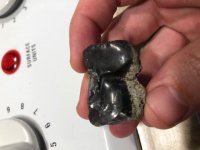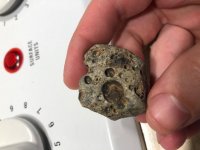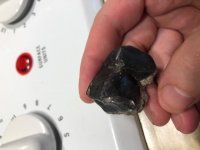I found this out fishing the other day and sent a picture to my friend who studies geology. She thought it was volcanic glass and pumice, but everything I've read suggests that there is really no volcanic glass to be found in north GA. Could this be impact glass?
You are using an out of date browser. It may not display this or other websites correctly.
You should upgrade or use an alternative browser.
You should upgrade or use an alternative browser.
Is this a meteorite or impact glass?
- Thread starter Barobi2
- Start date
Thirdeyeartifactguy
Jr. Member
Ive found this in Pennsylvania and ive been dieing to fifure out what it is lets hope we get some help. Mime is a bit more blue green than that but also has pourous parts to it like yours and then glassy parts. Its pretty heavy right?
Indian Steve
Silver Member
I'm thinking slag from an iron furnace
Red-Coat
Gold Member
Definitely not meteorite. The vesicles rule that out
You're correct that volcanic glass (obsidian), pumice and such wouldn't be naturally found in Georgia. I would agree that it's most likely slag as @Indian Steve says.
Georgia does have a strewnfield for meteoritic impact glass but it's pretty rare stuff. It's known as "Georgiaite" and it's usually a brown-amber colour in varying shades, sometimes with a greenish hue. It may occasionally be so dark that it appears to be black, but if you shine a light through it, the true colour shows up. I'm certain that isn't what you have. It occurs as isolated glassy droplets and fragments and wouldn't have grey vesicular material attached to it.
You're correct that volcanic glass (obsidian), pumice and such wouldn't be naturally found in Georgia. I would agree that it's most likely slag as @Indian Steve says.
Georgia does have a strewnfield for meteoritic impact glass but it's pretty rare stuff. It's known as "Georgiaite" and it's usually a brown-amber colour in varying shades, sometimes with a greenish hue. It may occasionally be so dark that it appears to be black, but if you shine a light through it, the true colour shows up. I'm certain that isn't what you have. It occurs as isolated glassy droplets and fragments and wouldn't have grey vesicular material attached to it.
While iron furnace slag is likely, based on location found, volcanic glass can not be completely ruled out. It does superficially resemble small obsidian nodules I have found in Nevada. Without further evidence, however, my opinion leans toward slag.
Time for more coffee.
Time for more coffee.
Red-Coat
Gold Member
Obsidian is not naturally found on the eastern side of the USA… often expressed in reference sources as “doesn’t occur naturally east of the Mississippi River” (although that’s not completely true).
The rationale for the statement is that obsidian readily weathers and hydrates to form the brownish-grey opaque mineral “perlite” and it typically only takes a few million years for this to happen. Given that there hasn’t been volcanic activity on the eastern side of the continent within that time, there should be no obsidian remaining.
That’s only a partial truth. Obsidian can and does survive a lot longer than that, but with most specimens being younger than 50 million years and nothing has been found that’s older than 66 million years. However, the geological record suggests that there should be no magmatic flows in the eastern parts of the USA from which obsidian could have formed within the last 200 million years.
There are only a few exceptions to this and the closest exceptions to Georgia are in Virginia. The Appalachian Mountains there have the remnants of two ‘young’ volcanoes: Mole Hill and Trimble Knob. Both of them are less than 48 million years old and exist today as the heavily-eroded necks and remnants of the interior of primeval volcanoes. They do nevertheless have the remains of gaseous vents within which there is still some unweathered obsidian, first identified and documented by geologists in 1899. The Smith and Dan Rivers originating in the Blue Ridge and Appalachian Mountains also carry occasional pieces of obsidian from these sources into the Piedmont along the NC/VA border.
Nevada is a whole different story. Obsidian is common in several locations because the state has seen 'recent' volcanic activity.
The rationale for the statement is that obsidian readily weathers and hydrates to form the brownish-grey opaque mineral “perlite” and it typically only takes a few million years for this to happen. Given that there hasn’t been volcanic activity on the eastern side of the continent within that time, there should be no obsidian remaining.
That’s only a partial truth. Obsidian can and does survive a lot longer than that, but with most specimens being younger than 50 million years and nothing has been found that’s older than 66 million years. However, the geological record suggests that there should be no magmatic flows in the eastern parts of the USA from which obsidian could have formed within the last 200 million years.
There are only a few exceptions to this and the closest exceptions to Georgia are in Virginia. The Appalachian Mountains there have the remnants of two ‘young’ volcanoes: Mole Hill and Trimble Knob. Both of them are less than 48 million years old and exist today as the heavily-eroded necks and remnants of the interior of primeval volcanoes. They do nevertheless have the remains of gaseous vents within which there is still some unweathered obsidian, first identified and documented by geologists in 1899. The Smith and Dan Rivers originating in the Blue Ridge and Appalachian Mountains also carry occasional pieces of obsidian from these sources into the Piedmont along the NC/VA border.
Nevada is a whole different story. Obsidian is common in several locations because the state has seen 'recent' volcanic activity.
Top Member Reactions
-
 2148
2148 -
 1022
1022 -
 973
973 -
 958
958 -
 854
854 -
 801
801 -
 789
789 -
 700
700 -
 583
583 -
 570
570 -
 465
465 -
 458
458 -
 447
447 -
O
445
-
 445
445 -
 431
431 -
 422
422 -
 379
379 -
 377
377 -
 373
373
Users who are viewing this thread
Total: 2 (members: 0, guests: 2)







